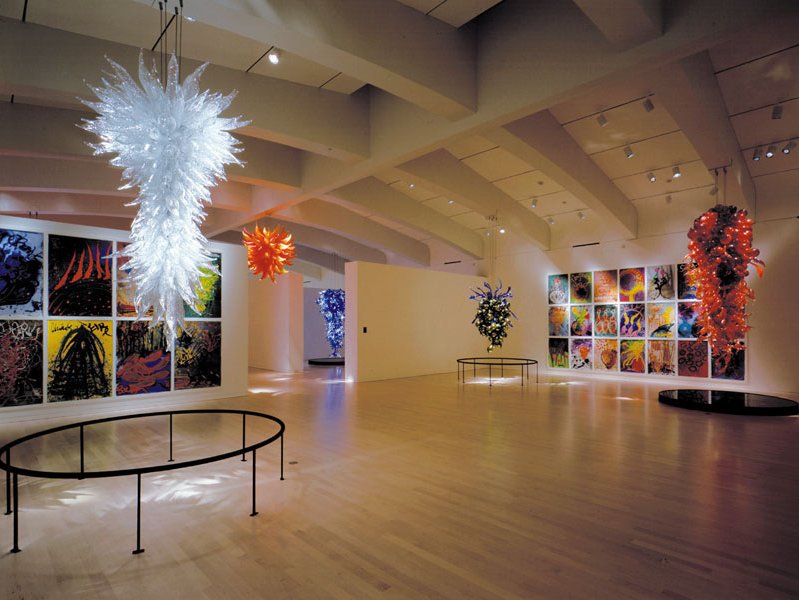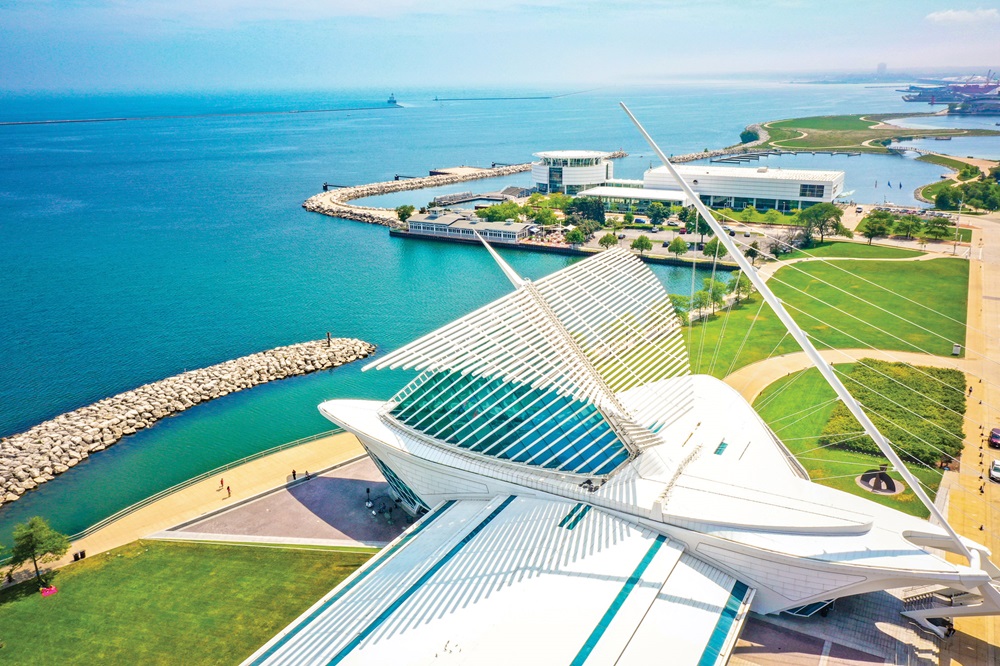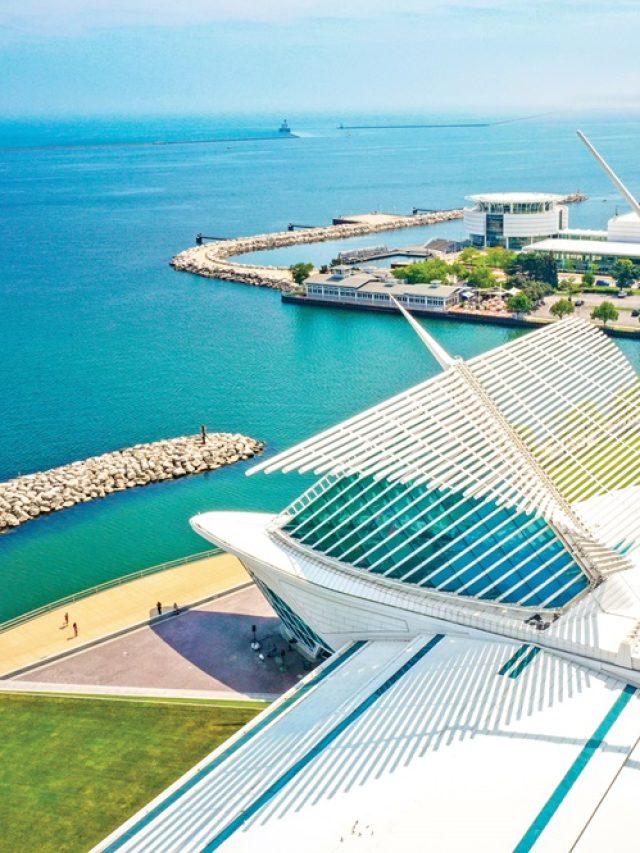The Milwaukee Art Museum (MAM) is a significant cultural institution in Milwaukee, Wisconsin. The Quadracci Pavilion, created by Spanish architect Santiago Calatrava, is one of its most notable architectural creations. More than 30,000 pieces of art, spanning from ancient to modern, are housed in the museum’s collection.
The famous Quadracci Pavilion is characterised by an opening and closing brise soleil that resembles moving wings and resembles a bird in flight. The museum’s War Memorial Centre, created by architect Eero Saarinen and inaugurated in 1957, honours those who served in the armed services. David Kahler designed the Kahler Building, and its expansion was finished in 1975.
The Milwaukee Art Museum (MAM) traces its beginnings to two institutions: the Layton Art Gallery, established in 1888, and the Milwaukee Art Institute, established in 1918. 1957, the groups joined together, forming the private, nonprofit Milwaukee Art Center, now known as the Milwaukee Art Museum. At this time, the Center moved to its present location on the Milwaukee waterfront. Finland’s Eero Saarinen, the architect responsible for the St. Louis Arch, designed the current centre home. Using cantilevered parts and floating cruciform sections, Saarinen produced a singular structure that is now regarded as a classic in the history of modern architecture. When the Milwaukee Art Centre was formed, the collections and initiatives of the Milwaukee Art Institute and Layton Art Gallery were merged, and the building opened in 1957.
The Architect

The highly recognised architect Santiago Calatrava was born in Valencia, Spain, on July 28, 1951, and graduated from the Escuela Tecnica Superior de Arquitectura with a degree in architecture. After completing his architectural study, Calatrava attended the Federal Institute of Technology (ETH) in Zurich to pursue post-graduate studies in civil engineering, where he earned his Ph.D. in 1979. After his education, Calatrava started his career by undertaking small engineering projects. He also participated in design contests because he thought this was the best approach to getting commissions. In 1983, he won a competition with a design and construction plan for Zurich’s Stadelhofen Railway Station.
The Turtle Bay Bridge in Redding, California (summer 2004), the Athens Olympic Sports Complex (summer 2004), and the Valencia Opera House (2004)—the final significant structure in his City of Arts and Sciences—are among the projects that are almost finished. Recently, Calatrava was chosen to create two critical projects in the United States: Symphony Centre for the Atlanta Symphony Orchestra in Atlanta, Georgia, and Christ the Light Cathedral for the Roman Catholic Diocese of Oakland, California. The architect has been granted 12 honorary doctorates, accolades, and awards from internationally renowned architecture groups. Time Magazine named Calatrava one of the “Best of 2001” for his work expanding the Milwaukee Art Museum. Furthermore, the Illuminating Engineering Society granted him the International Illumination Design Award of Merit.
The Quadracci Pavilion
To “set an architectural standard for the next millennium,” the city of Milwaukee aimed for a “strong architectural statement in an exciting yet functional building.” “A glowing ‘lantern’ on the downtown lakefront, radiating light in all directions” was Calatrava’s reaction. He decided to put this idea into practice with a pavilion that included a “huge, wing-like sunscreen” and a “vast, glass-enclosed reception hall” with a “transparent, boat-like prow of unique design, facing the lake.”
“The project’s steel-and-glass Quadracci Pavilion, which will serve as the grand entry into the expanded museum, will be erected over a concrete ring beam immediately south of the low-lying galleria. Seventeen specially built A-frames, ranging from 98 feet to about 27 feet, have been trucked in from Portland, Ore., for assembly and placement on the work site. Erection is slated to begin this week. The A-shaped rafters were computer-designed and custom-fabricated by Columbia Wire and Iron Works, a speciality steel fabricator in Portland. Together, they’ll give the pavilion its shape, strength and transparency. Components for the A-frames were cut out of big sheets of steel plate, welded together, ground and finished. Shapes were determined digitally from a computerized model of the pavilion and its underlying structure. Once the A-frames have been placed on the oval-shaped ring beam, glass panes will be inserted, followed by a three-piece steel spine. The fixed ‘building spine’ will top off the A-frames. Above it, two rotating spines will support the movable wings of the Brise-Soleil, an enormous sunscreen that can be positioned to admit or keep out sunlight. Light is crucial in the concept and operation of the pavilion. By day, it will have natural light. At night, artificial illumination will be provided by powerful lights set low around the concrete ring beam. Thus, said David Kahler, president of architect-of-record Kahler Slater, the pavilion will be precisely as architect Santiago Calatrava originally envisioned it: a glowing ‘lantern’ on the downtown lakefront, radiating light in all directions”, writes James Auer of the Milwaukee Journal-Sentinel Online.
Urban Context

Milwaukee’s waterfront landmark, the Calatrava expansion of the Milwaukee Art Museum, has gained notoriety. Situated next to Wisconsin Avenue, a primary thoroughfare in Milwaukee, the structure is linked to the town via a cable-stay footbridge. Moreover, the bridge was the most appropriate from a safety perspective because it spans the heavily travelled Lincoln Memorial Drive, making the region pedestrian-friendly. In addition to adding roughly thirty per cent of new display space to the museum, the extension also addressed a few other socio-political issues.
The Haggerty Museum of Art
Milwaukee, Wisconsin’s Haggerty Museum of Art is situated on the campus of Marquette University. It was founded in 1984 and serves as an educational resource for teachers, students, and the general public. The museum collection includes artworks from different eras and places, such as modern and contemporary art, as well as paintings, prints, photos, and decorative arts from Europe and America. The museum’s permanent collection comprises more than 4,500 artefacts created by artists such as Marc Chagall, Salvador Dalí, and Andy Warhol.
Temporary exhibitions covering a wide range of themes and artists are periodically held at the museum; these exhibitions frequently feature contemporary art and socially significant topics. To engage visitors of all ages and backgrounds, the Haggerty Museum offers a range of educational programmes, including lectures, workshops, and tours.
Charles Allis Art Museum
The Charles Allis Art Museum is housed in a historic mansion on Milwaukee’s East Side. Renowned Milwaukee architect Alexander Eschweiler created the mansion, which was constructed in 1911 for Charles and Sarah Allis. Allis’s vast collection of decorative and fine arts is on display at the museum, offering visitors a window into the aesthetic and cultural preferences of the early 1900s.
The museum is housed in a magnificently maintained mansion that has kept much of its original interior decor and architectural appeal. European and American artists’ paintings, prints, sculptures, and decorative arts from several centuries ago are part of the Allis collection. The artwork of artists like Jean-François Millet, Thomas Gainsborough, and Jean-Baptiste-Camille Corot are among the highlights.
The Milwaukee Art Museum is a tribute to the rich cultural legacy of the city and a beacon of artistic achievement. In addition to housing a top-notch collection of artwork spanning ages and countries, the museum’s famous Quadracci Pavilion, created by architect Santiago Calatrava, is a spectacular architectural landmark on the shores of Lake Michigan. All ages are inspired and educated by the museum’s varied exhibitions, educational offerings, and dedication to community involvement. The Milwaukee Art Museum invites everyone to investigate the beauty and relevance of art in our lives as it continues to be an important cultural centre as Milwaukee changes.






